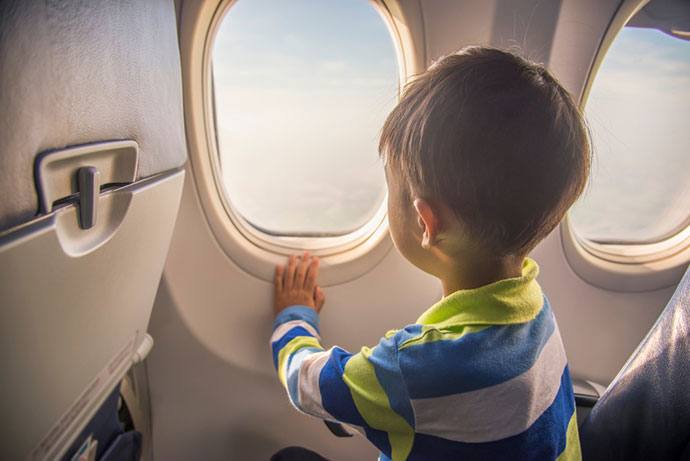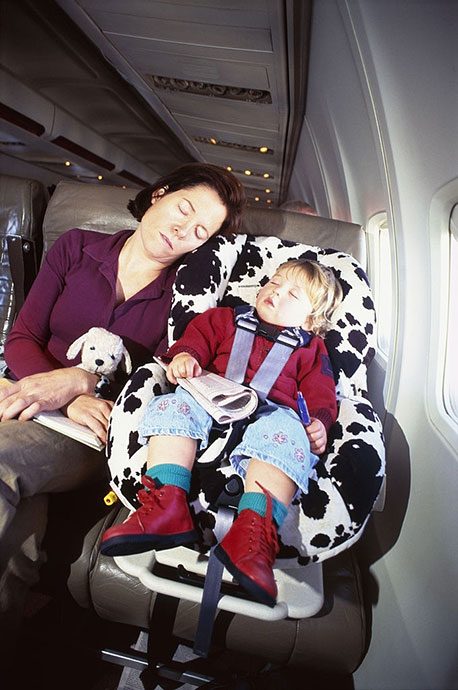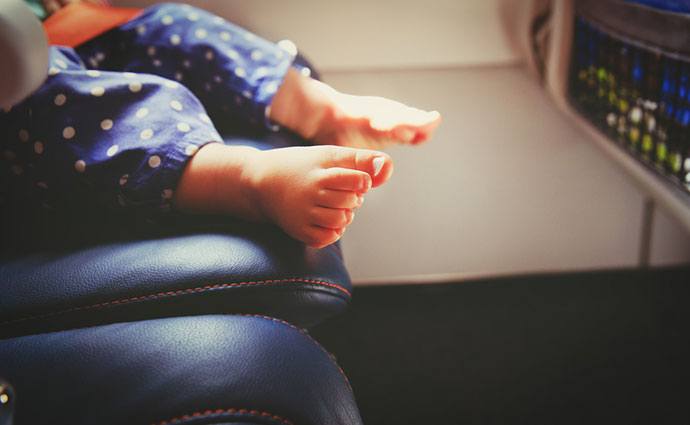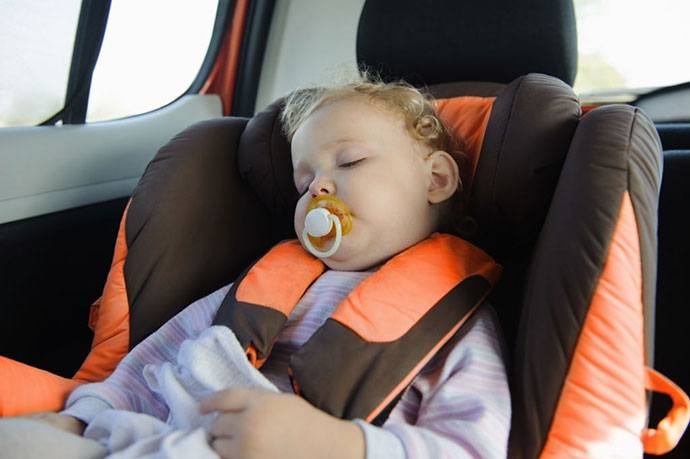A kid's wellbeing is the number one priority of every responsible parent. However, transportation of any kind carries a certain degree of risk, which parents are never willing to take.
Regulations and policies concerned with this matter are continuously changing and updating. Sometimes, it is hard to follow the advisable thing when traveling with a child.
In this informative text, you may find all the essential information on the best ways to accommodate a child in a plane safely. If you have done some research yourself, you're probably considering flying with a car seat; and you're going in the right direction.
While holding a child in your lap is a legitimate form of child accommodation on aircraft, the American Academy of Pediatrics recommends mandatory restraints of children younger than two years.
To choose the safest option possible for your toddler, keep reading and get familiar with FAA and NTSB regulations, learn how to fly with a car seat safely, and what the other recommended alternatives are.
More...
Table of Contents
- What Are the Official Regulations for Flying With Children in the USA?
- Is Holding Your Child on a Lap Safe?
- What Is the Advice of Pediatricians?
- What Are the Child Safety Seats?
- What Is the Best Car Seat to Fly With?
- Do I Need to Pay for Another Seat for My Child if I Am Using a Car Seat?
- How to Properly Install a Car Seat on a Plane?
- What Are the Regulations in Other Countries?
- How to Prepare for Flying With Children?
- How to Take Your Car Seat to the Airplane?
- Final Thoughts
What Are the Official Regulations for Flying With Children in the USA?

If you're planning to fly with your toddler, you must be wondering what the official regulations are.
While all the reputable administrations and boards recommend and advise using safety restraining systems or devices for children under the age of two, it is not mandatory.
In fact, a child under the age of two can be held on the lap of a mother, father, or another family member throughout the entire flight, as established by the US Code of Federal Regulations. However, you would need to contact your airline to get the information on how old a person holding the child must be.
Also, passengers caring for small children are prohibited from sitting in exit row seats.
Read more —
Is Holding Your Child on a Lap Safe?
While this option seems like the most cost-efficient solution and additionally safe since many parents believe to be capable of maintaining a firm grasp of their child even during the turbulence, it is not a good idea.
The National Transportation Safety Board has issued the standard regulations and recommendations concerning children's safety in an aircraft after the sudden crash of a McDonnell Douglas DC-10-10. It was operated by United Airlines as Flight 232 in 1989. The accident proved that no parent was capable of keeping their toddler or infant on the ground in a safe brace position during the turbulence and the eventual crash. More plane crashes with a similar outcome have additionally emphasized the problem.
Researchers at the FAA's Civil Aeromedical Institute have proven on dummies that it is incredibly improbable and almost impossible to keep a child in a safe grasp even during minor turbulence.
Therefore, while you are permitted to hold a toddler in your lap, it is not advisable. You won't be able to protect and maintain your child in a safe position during a potential accident or sudden turbulence.
What Is the Advice of Pediatricians?

The American Academy of Pediatrics strongly encourages and even demands a federal regulation that would require mandatory use of a restraining system for children under two years of age on aircraft.
As they argue, even the pots of coffee need to be secured on a plane, yet toddlers do not. Moreover, cases of preventable deaths and injuries among toddlers were recorded during survivable plane crashes and turbulence, which further stresses the problem.
To answer the American Academy of Pediatrics, the FAA has issued a mandatory requirement for child safety seats (CSS) to cause even more injuries because parents who cannot afford another place for their toddlers decide to travel by car. Any viable data of statistics did not support these assumptions.
While the chances for a severe injury in aircraft are negligible, they should be entirely prevented. Therefore, The American Academy of Pediatrics strongly suggests CSS usage to ensure children’s maximum safety. As they say, CSS should be the first thing parents pack when flying with a toddler.
What Are the Child Safety Seats?
Child safety seats are hard-backed seats specially designed to ensure the safety of a child in transport. These seats are governmentally approved for use both in motor vehicles and aircraft.
There are also booster seats and harness vests, but while they are widely used in vehicles, the FAA does not recommend them for airplanes as they don't provide the appropriate protection during takeoffs and landings.
Not every car seat is suitable for airplane use, so make sure your seat has the "This restraint is certified for use in motor vehicles and aircraft" label on it.
When it comes to harnessing devices, the only booster seat approved by the FAA is the CARES harness device, approved for children from 22 to 44 pounds in weight. Also, these devices are only accepted in airplanes and not in vehicles.
What Is the Best Car Seat to Fly With?

In 1993, crash testing was performed on dummies to determine what type of car seats are the safest for airplanes. It proved that rear-facing car seats performed exceedingly well and could be installed easily with airplane seat belts.
However, forward-facing seats were harder to secure and, therefore, won't serve as well as rear-facing car seats. However, if your child is too old for rear-facing car seats, a forward-facing seat is the best option.
You can find more information on the types of car seats and the best options for your child concerning their age and physique on this page.
Do I Need to Pay for Another Seat for My Child if I Am Using a Car Seat?
Well, the law says YES, but airplane policies vary. Some airlines may allow you to install a car seat for your child if there are some empty seats, but they are not obligated to. On the other hand, If you pay for an extra seat and inform the airline that you will travel with a child, they are compelled to find the right place suitable for your FAA-approved child safety seat.
If your seat has a base too broad to feat the airplane seats with rigid armrests, the airplane staff must enable a seat with moveable armrests for you.
If your car seat cannot be installed correctly because of the minimal distance between rows, the airplane staff can move you to a bulkhead seat or a seat in a row with extra space but in the same class.
However, you are not allowed to install the CSS in the exit row seats.
Now, when you reserve the seats, call your airline and make sure you get the place right next to your toddler. Also, check the seat dimensions and compare them with the measurements of your car seat.
The airlines are obligated to provide the exact dimensions of all of their seats on their websites or via phone. So, don't forget to check this information.
How to Properly Install a Car Seat on a Plane?
Since we mentioned that your first choice should be a rear-facing car seat, we will first give a step by step guide for the installment of these seats exactly.
First of all, ask the flight attendant for a seatbelt extender because you will need it for easier maneuvering and to keep the buckle out of the belt path, which is essential when you detach the seat.
Now, the installment is very straightforward if you can attach the seat base to fit the airplane seat correctly; in that case, follow the next steps.

- 1Loosen the seat belt extender as much as possible for more comfortable use.
- 2Raise the armrest.
- 3Slide the extender through the rear-facing belt path.
- 4Place the rear-facing seat in the airplane seat.
- 5Connect the extender with the airplane seatbelt on both sides.
- 6Push the seat with one hand and fasten the belt with another, try to eliminate any slack.
- 7Check if the seat can move more than an inch side to side and front to back.
- 8If the rear-facing seat can move more than an inch, push the seat once again and fasten the bet even more.
- 9When the seat moves less than an inch, you have installed the rear-facing car seat properly.
Here is a useful video that can guide you through the process and remove any confusion, if you have it.
The problem with rear-facing seats is that sometimes the base can not fit the seat, or the seat belt buckle is on the way so the seat cannot match the base properly. If that is the situation, what you will have to do is install the seat without the base.
You can do so by closely sticking to these steps:

- 1Ask the flight attendant for the seat belt extender.
- 2Raise the armrest.
- 3Place your rear-facing car seat in the airplane seat next to a window.
- 4Connect the belt extender with the airplane seat belt on both sides.
- 5Tuck the airplane belt extender into the lap belt guide on both sides of the rear-facing car seat.
- 6Make sure you turn the buckle over 180 degrees so your child does not unbuckle it.
- 7Fasten the belt extender until the rear-facing car seat can not move more than one-inch side to side and front to back.
- 8If your rear-facing car seat is small enough and does not need the belt extender, simply buckle up the original airplane seat belt.
- 9Lower the armrest.
Now, if you're flying with a forward-facing car seat, these are the recommended steps to follow to install your seat correctly:

- 1Before installing the seat, make sure you position the harness straps to fit your child properly.
- 2Raise the armrest.
- 3Place your seat in the center of the airplane seat, forward-facing.
- 4Thread the seat belt through the forward-facing belt path ben]hing the seat pad.
- 5Fasten the seat belt.
- 6You can place your knee on the seat, one arm on the seat back, and pull the belt with the other arm.
- 7If you can move the seat more than one-inch side to side or front to back, you need to fasten the belt more.
- 8Lower the armrest.
- 9Seat your child in the seat.
- 10Slide harness straps over your child's shoulders.
- 11Insert the buckle tongues into the bucks and check if they're engaged.
- 12Snap together the two sides of the chest clip.
- 13The chest clip must be positioned at armpit level.
- 14Check the harness straps to eliminate any slack.
Now, here is the official FAA video that may help you understand the process better.
When it comes to the CARES child safety device, these are the steps you should follow to install the device in the airplane seat properly:
- 1Seat your child in the airplane seat.
- 2Lower the tray table behind the seat of your child.
- 3Slide the red loop over the seat back and place it at the height of your child's shoulders.
- 4Fasten the strap.
- 5Slide the clip over the excess strap.
- 6Return the tray table in the closed position.
- 7Place the shoulder straps over your child's shoulders.
- 8Slide the seat belt connector and buckle through the loops on vertical straps.
- 9Buckle the seat belt and tighten it snuggly.
- 10Connect the chest clip.
- 11Adjust the shoulder straps, so your child is firmly secured.
- 12Your child is safely fastened.
If you still don't feel confident and need a bit more assistance to figure this out, look at this official FAA video on how to install the CARES
However accurate these instructions were, never forget to check the manufacturer's instructions for your device specifically. These are the most accurate and safe instructions; therefore, always refer to them first.
What Are the Regulations in Other Countries?

Canada has pretty much the same regulations when it comes to flying with car seats as the USA. Namely, children under the age of two can be held on the lap of a parent, but they strongly recommend using child safety seats. The seats need to comply with Canadian and international standards that you can check on this link.
CARES child safety devices are accepted only on some airlines, so you would need to check it with your airline upfront.
The devices they do not accept on aircraft are booster seats, vests and harnesses, infant carriers, belly and loop belts.
Also, Canada demands one responsible grown-up for one child; therefore, you will need another adult to fly if you travel with two kids.
Europe has slightly different standards when it comes to the regulation of flying with children. They also allow for a child younger than two years to sit on an adult's lap, but they provide an infant seat belt to secure your child. This is necessary.
You might have to contact your specific airline for information on whether the car seat can be used on their airplane, even if it's approved for use on aircraft; in Europe, it depends on the airline policy whether you can use it or not.
You can also use the ISOFIX and high-back booster seats in some European regions; more information you can find in this official leaflet, and consult your airline for the info. Other devices approved for aircraft use in Europe are the Meru Travel Chair, Baby Bassinet, and Amsafe CARES device.
Once again, always contact your airlines for accurate information, since in Europe, the policy on the use of CSS on aircraft depends on the airline's policy. The additional information you can find on the official site of the European Union Aviation Safety Agency.
How to Prepare for Flying With Children?
It is strongly advised to contact your airlines and inform them that you will be flying with a child. They will provide all the essential information you need and brief you on their policies on the matter.
Always ask about the pre-boarding options, and If the airline allows it, don't miss it by any means. Pre-boarding will spare you the trouble because you need extra time carrying a car seat and caring about your youngster. Pre-boarding will provide more time for you to install the device, and the staff will have time to brief you on the safety measures for you and your child.
Also, make sure you bring everything necessary for your child. The recommendations include the approved safety car seat (check with your airline), a stroller (check with your airline), diapers, wet wipes, change of clothes, a pacifier, formula, changing pad, bottles with water, medications, snacks, favorite toys, books or cartoons, etc.
These are the standard recommendations, but I am sure every mother knows best what her child needs; just make sure you're fully prepared for the entire flight duration.
How to Take Your Car Seat to the Airplane?

This is the part where you get creative. The standard and frankly, the simplest way is to carry the car seat by yourself; this way, you will avoid any extra luggage or device that you will need to take with you on the plane and have to carry when you get to the destination.
Some people use foldable strollers as they are very compact, but you'll need to gate check it and still carry the car seat to the airplane. Another incredible option is to use the car seat cart and then fold and store it in the carry bag and check it at the gate. It is always advisable to come with another adult if you're traveling with a really young child.
You will have a lot of trouble taking care of your kid's safety and bringing all that baggage with you. Sometimes you can get tired, frustrated, or simply exhausted, which may result in a lack of energy for your little one.
Be responsible, organize your flight ahead, ask someone to join you on the plane, and help you with the car seat and luggage; and If you're traveling with more than one kid, do not by any means travel alone. In the case of an emergency, evacuating two kids at once is almost impossible and may jeopardize other passengers' safety.
Final Thoughts
To sum it all up, flying with car seats is definitely the safest option to accommodate your child during the flight.
While it is allowed to hold your toddler on your lap, it has been proven in the experience that it may result in preventable injuries or even fatal results if a plane crashes or some disturbances occur. You will need to pay for your child's extra seat if you plan to use a car seat for his/her accommodations.
Some airlines may allow you to use an extra seat for free, but you'll need to check it with them upfront, and there's always a risk that all the seats could be taken. Airlines in the USA are obliged to provide you the appropriate seat for your CSS if you paid for an extra seat and contacted them about it; however, you will not be allowed to install it in the exit row seat.
Regulations in other countries are similar, but always check with your airline their policy on the matter.
